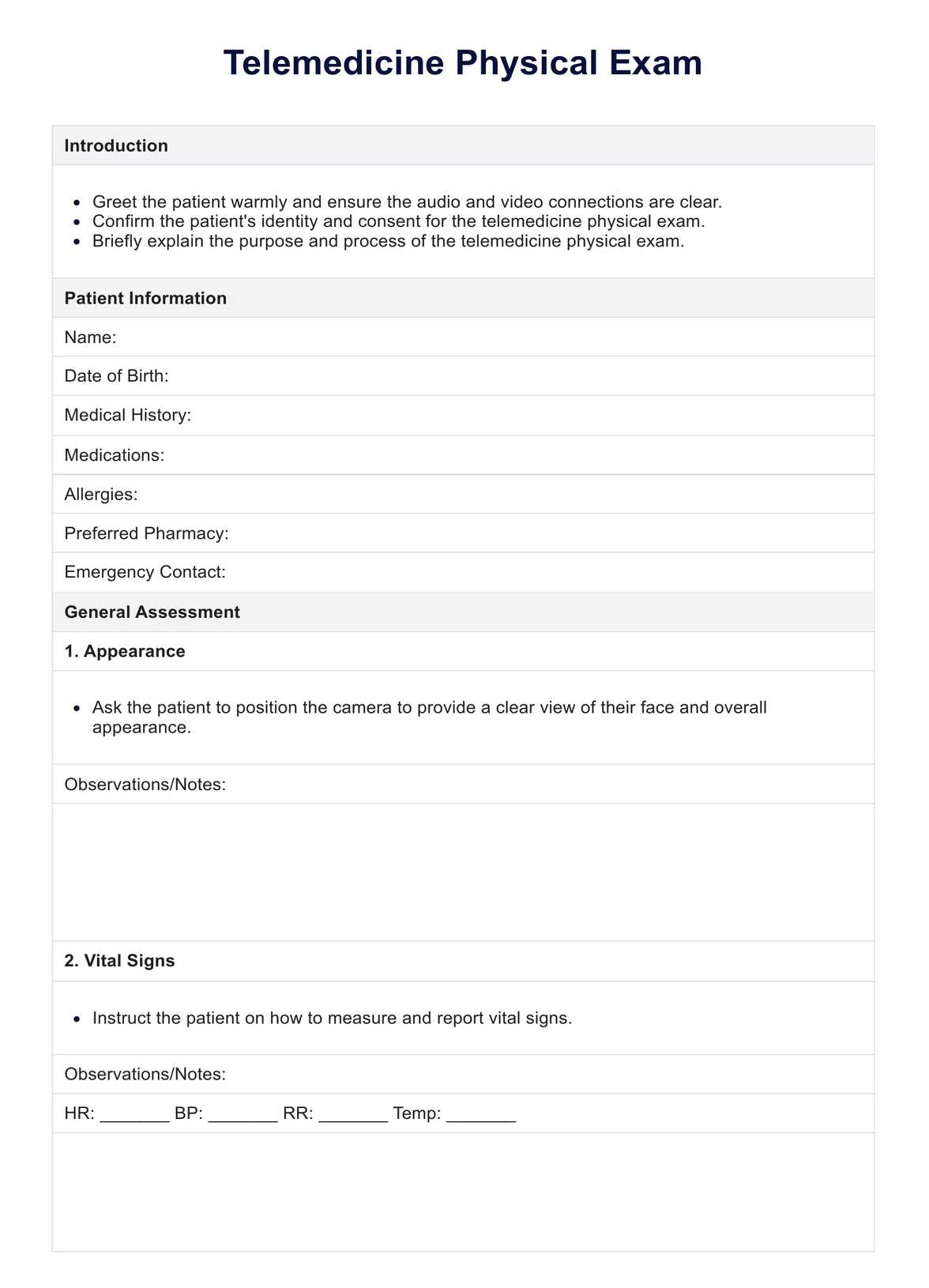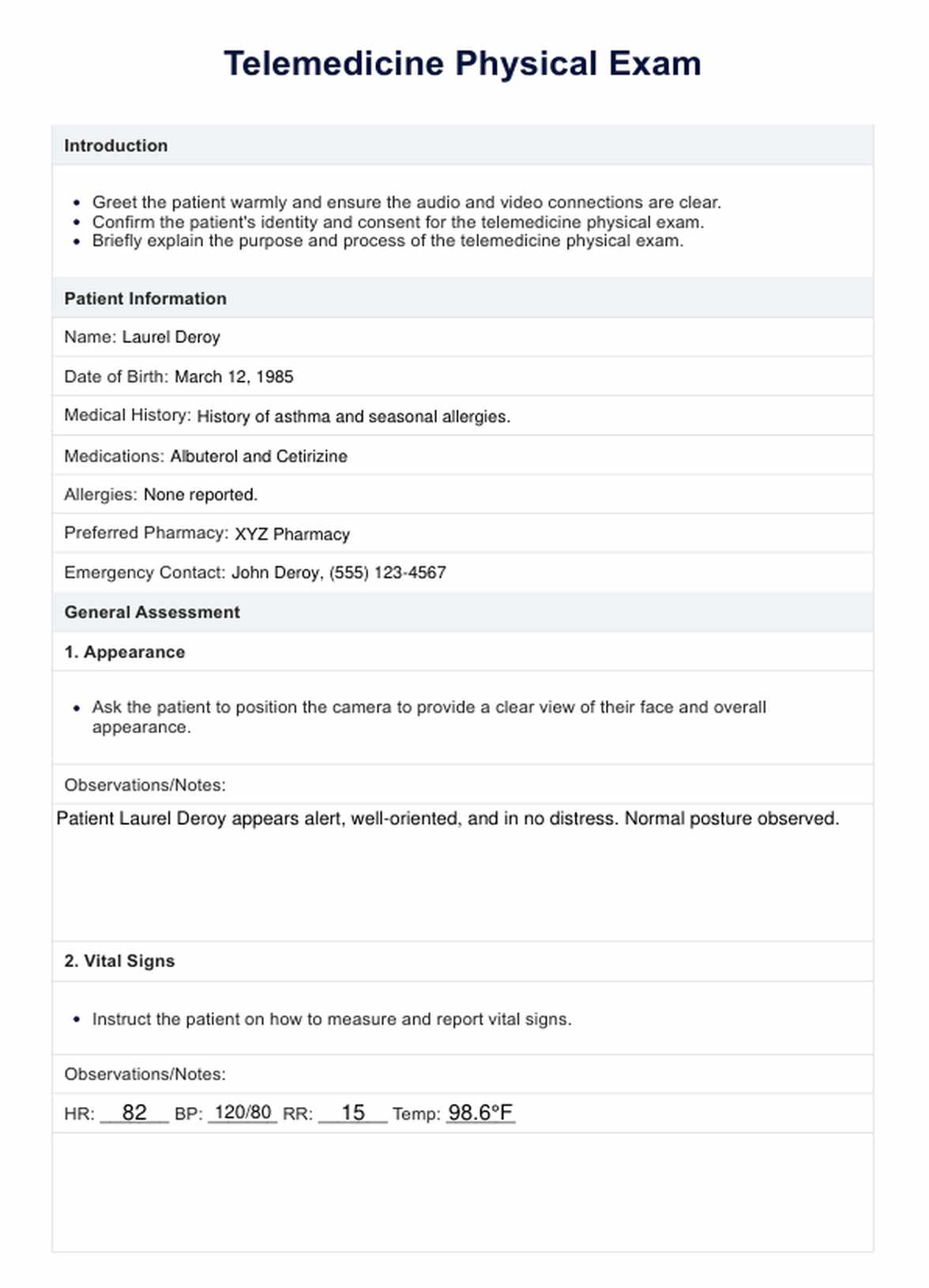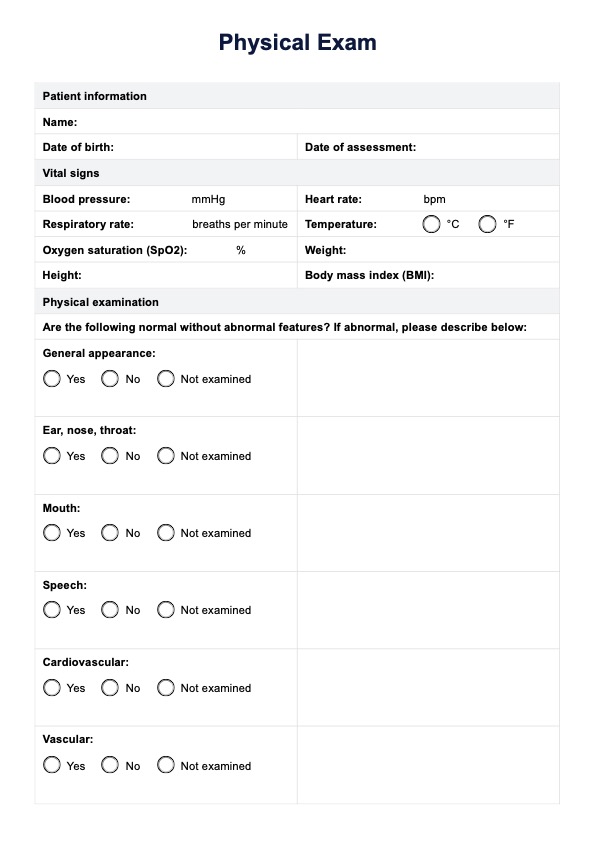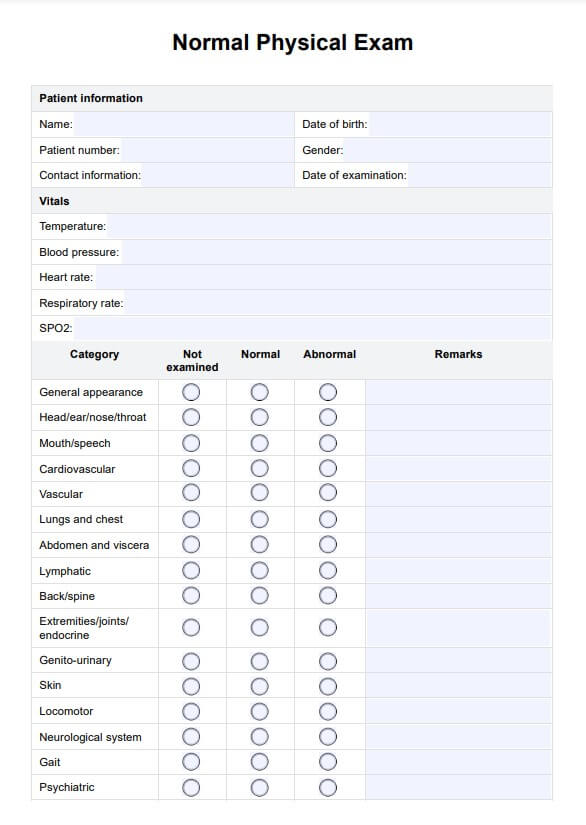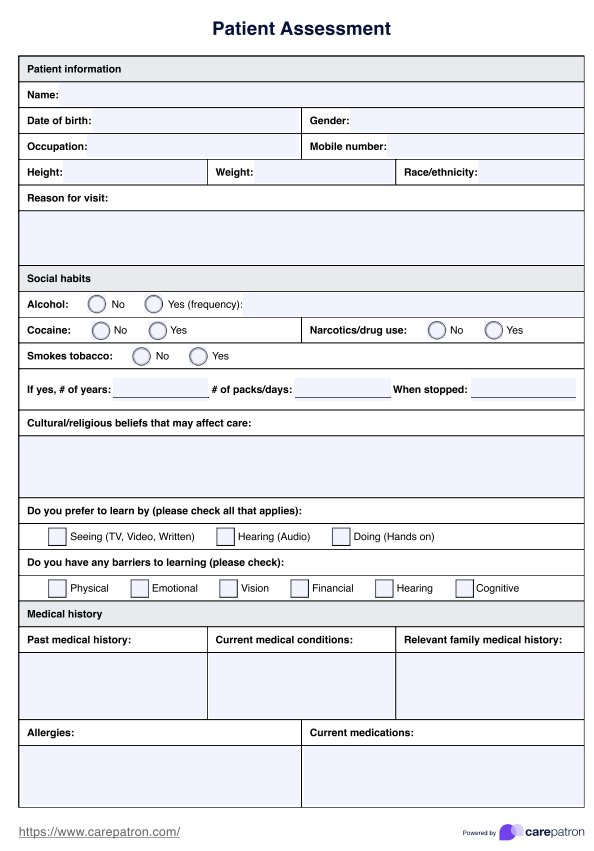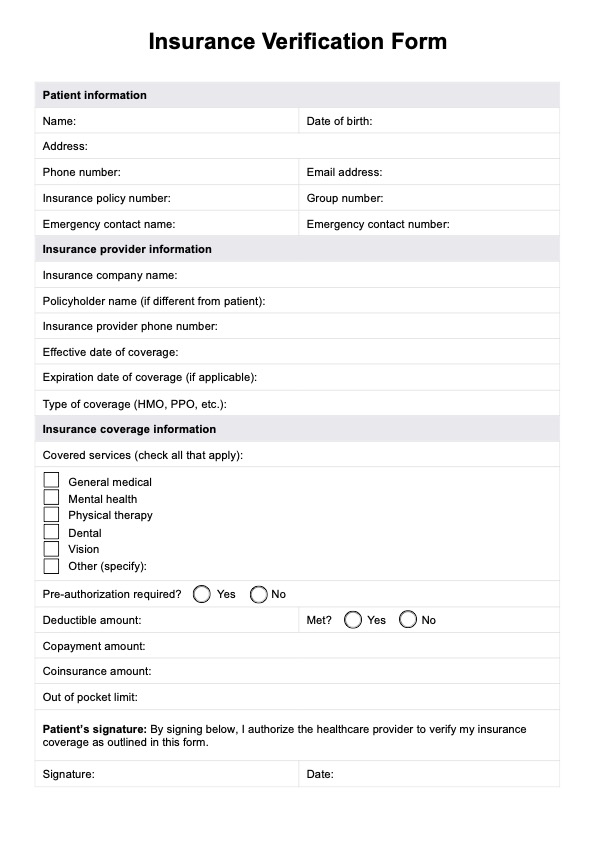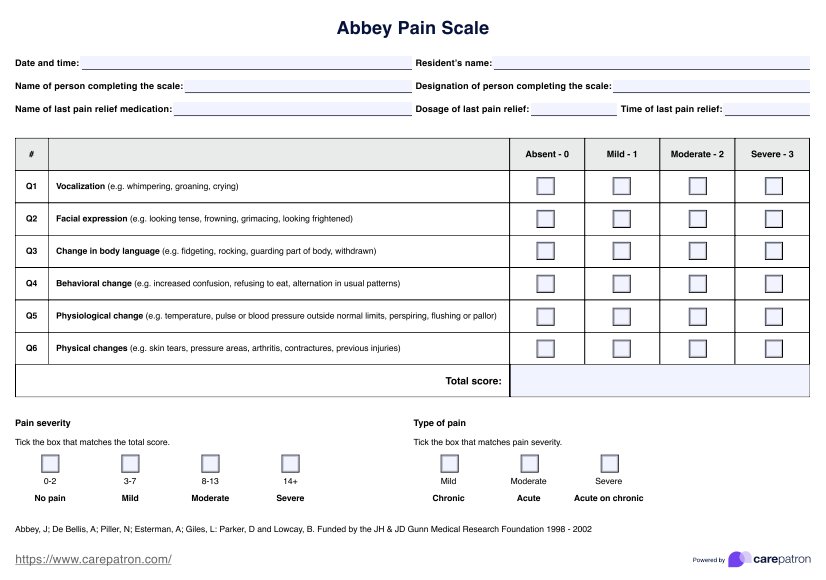Telemedicine Physical Exam Template
Explore a comprehensive Telemedicine Physical Exam template with examples. Download the free PDF for a structured guide to remote healthcare assessments.


What is telemedicine?
Telemedicine, a revolutionary facet of modern healthcare, leverages technology to facilitate remote patient care and consultations. Unlike traditional in-person visits, telemedicine allows medical professionals to conduct various healthcare services virtually, bridging geographical gaps and enhancing accessibility. One significant aspect of telemedicine involves the performance of physical exams through digital platforms.
In telemedicine, medical professionals use videoconferencing tools to connect with patients. This virtual interaction enables healthcare providers to conduct physical exams remotely, guiding patients through specific clinical tests while assessing their condition. Through the patient's camera, medical professionals can gain valuable insights into the patient's physical appearance and presentation, enhancing their ability to make informed healthcare decisions.
Telemedicine's versatility extends beyond routine consultations. Medical professionals can directly observe and guide patients through movements, allowing for a dynamic assessment of range of motion, muscle strength, and other vital physical aspects. The patient's picture, conveyed through the digital interface, becomes a crucial diagnostic tool, enabling healthcare providers to offer personalized care and make well-informed medical decisions based on real-time observations.
Telemedicine Physical Exam Template
Telemedicine Physical Exam Template Example
What is included in an annual physical exam?
An annual physical exam is a comprehensive health checkup to evaluate an individual's well-being. This routine examination encompasses various elements to provide a holistic understanding of a person's health status.
Blood pressure and vital signs
An integral component of an annual physical exam is the assessment of vital signs, including blood pressure. Monitoring blood pressure helps identify potential cardiovascular issues and contributes to the early detection of conditions like hypertension. By examining vital signs, healthcare professionals gain valuable insights into the body's basic functions, allowing for a baseline understanding of the patient's health.
Physical examination
A thorough physical examination is a cornerstone of an annual checkup. Healthcare providers examine various aspects of the body, including the head, eyes, ears, nose, throat, and skin. They assess the musculoskeletal system, looking for signs of abnormalities, discomfort, or limitations in range of motion. Additionally, abdominal and neurological examinations may be conducted to ensure a comprehensive evaluation of the patient's physical health.
Specific clinical tests
Depending on the individual's age, gender, and medical history, specific clinical tests may be included in an annual physical exam. These tests can encompass screenings for cholesterol levels, blood glucose, and other metabolic markers. Cancer screenings, such as mammograms or prostate exams, may also be recommended based on the patient's risk factors. Including specific clinical tests enhances the exam's ability to detect underlying health issues early on.
An annual physical exam is a multifaceted approach to preventive healthcare, encompassing the measurement of vital signs, a comprehensive physical examination, and targeted clinical tests tailored to the patient's unique health profile. Regular checkups play a crucial role in maintaining optimal health and preventing the progression of potential medical conditions.
How do virtual physical exams work?
In telemedicine, virtual physical exams offer a novel approach to healthcare, allowing patients to receive thorough medical assessments from the comfort of their homes. The process involves several key steps, each contributing to a comprehensive patient health evaluation.
Step 1: Patient connection and introduction
The virtual physical exam begins with patients connecting to a secure telemedicine platform. This initial step establishes a secure and private environment for the medical encounter. The physician introduces the telemedicine session, ensuring the patient's comfort and understanding of the process.
Step 2: Documenting patient information
Physicians gather essential patient information during the virtual encounter. This includes confirming the patient's identity, reviewing medical history, and documenting details such as allergies, medications, and preferred pharmacy. This step lays the groundwork for a personalized and informed examination.
Step 3: General assessment and observation (camera utilization)
Physicians guide patients to position their cameras appropriately to facilitate a clear view of their faces and overall appearance. Through the virtual lens, physicians observe the general appearance, signs of distress, or any visible abnormalities. This real-time observation serves as a foundation for the subsequent evaluation.
Step 4: Vital signs assessment
Patients are instructed to measure and report vital signs, including heart rate, blood pressure, respiratory rate, and temperature. Physicians guide patients through the process, ensuring accurate and reliable self-reporting. This step provides critical information on the patient's physiological status.
Step 5: Symptom review and patient statements
Physicians discuss their chief complaints and specific symptoms with patients. Open-ended questions gather information about symptoms' onset, duration, and characteristics. Patient statements are documented to enhance understanding of the individual's health concerns.
Step 6: Functional assessment (range of motion and muscle strength)
Physicians guide patients through a simple range of motion exercises and muscle strength tests. Through verbal instructions and visual observation, physicians assess any limitations, discomfort, or abnormalities in physical activity, providing insights into musculoskeletal health.
Step 7: Neurological assessment and specific system review
Basic neurological assessments include tests for sensation, coordination, and reflexes. A specific system review may be performed depending on the patient's condition. Physicians adapt the virtual platform to address each patient's needs, ensuring a comprehensive evaluation.
Step 8: Medication review and review of labs/imaging
Physicians discuss the patient's current medications, dosage, and any side effects. If applicable, recent laboratory results or imaging studies are reviewed. This step ensures that the virtual physical exam considers the broader context of the patient's health.
Step 9: Follow-up and recommendations
Physicians summarize the virtual physical exam findings and discuss treatment plans, prescriptions, and further evaluation or test recommendations. Follow-up appointments are scheduled as needed to monitor progress and address ongoing health concerns.
Virtual physical exams seamlessly integrate technology, allowing physicians to guide patients through a structured assessment process remotely. The steps outlined in the template ensure a thorough evaluation of the patient's health, leveraging the capabilities of telemedicine to provide personalized and accessible healthcare.
Preparing your patients for a virtual physical exam
As telehealth visits become increasingly prevalent, preparing patients for a virtual physical exam is crucial to ensuring a seamless and effective healthcare experience. Incorporating video technology into medical assessments brings forth unique considerations. Here's a comprehensive guide on how healthcare professionals can help patients feel comfortable and informed before a virtual physical exam.
Introduction to telehealth visit
Begin by explaining the concept of a telehealth visit to patients. Clearly articulate how this approach enables them to receive medical care remotely, emphasizing the convenience and accessibility it offers.
Navigating video technology
Provide step-by-step instructions on accessing and using the video technology chosen for the telehealth visit. Offer a tutorial or share resources that guide patients through setting up and testing their audio and video connections.
Addressing patient concerns
Proactively address common concerns patients may have about virtual exams. Address issues related to privacy, security, and the confidentiality of their health information to alleviate any apprehensions.
Setting the stage for comfort
Encourage patients to find a quiet, well-lit space for the virtual physical exam. Remind them that choosing a location with minimal background distractions contributes to a focused and effective healthcare interaction.
Utilizing electronic messages
Leverage electronic messages to communicate essential information before the video visit. Send reminders, instructions, and any required forms electronically. This ensures patients are well-prepared and know what to expect during the virtual exam.
Ensuring technical readiness
It is recommended that patients conduct a technical readiness check before the telehealth visit. Ensure their devices are charged and software is updated to prevent any disruptions during the examination.
Facilitating a mock video visit
Offer the option for patients to participate in a mock video visit to familiarize themselves with the technology and the virtual examination process. This can significantly reduce anxiety and enhance their comfort level.
Providing support resources
Share resources, such as user guides or frequently asked questions (FAQs), that patients can reference at their convenience. These resources serve as handy references for troubleshooting and clarifying common queries.
Encouraging questions and communication
Emphasize the importance of open communication. Encourage patients to ask questions about the virtual physical exam process, ensuring they feel empowered and informed throughout the healthcare journey.
Preparing patients for a virtual physical exam involves clear communication, technical guidance, and proactive support. By implementing these steps, healthcare professionals can contribute to a positive and successful telehealth experience, ultimately enhancing patient satisfaction and engagement.
The benefits of virtual physical exams
The surge in popularity of virtual physical exams has been underscored by myriad benefits, reshaping the landscape of healthcare delivery.
One notable advantage is the ability to perform direct specific clinical tests remotely. Through virtual visits, healthcare professionals can guide patients in conducting specific tests, assess their physical condition, and provide real-time feedback. This approach not only enhances accessibility to healthcare but also allows for tailored assessments without the need for in-person visits, particularly valuable during circumstances like the COVID-19 pandemic, where minimizing physical interactions is essential.
Amidst the challenges presented by the COVID-19 pandemic, virtual physical exams have emerged as a vital solution, offering a safe and efficient healthcare delivery. Patients can now receive medical assessments without the need to physically present themselves in a clinic, reducing the risk of viral transmission.
This approach has proven particularly beneficial for routine check-ups, follow-up appointments, and monitoring chronic conditions, ensuring that individuals can maintain their health and well-being while adhering to public health guidelines. As we navigate the evolving landscape of healthcare, the noted benefits of virtual physical exams stand as a testament to the adaptability and resilience of modern medicine.
To further enrich your practice and boost client satisfaction, explore the annual physical exam template and physical exam template.
Commonly asked questions
Telemedicine Physical Exams are valuable for many routine assessments, but certain conditions may require in-person examinations for a more hands-on evaluation. Always follow your healthcare provider's recommendations.
To prepare, ensure a quiet, well-lit space with a stable internet connection. Familiarize yourself with the video platform, have any relevant medical information ready, and be prepared to discuss your symptoms and medical history.
Many insurance providers now cover Telemedicine services, especially as they become more widely adopted. It's advisable to check with your insurance provider beforehand to understand your coverage and associated costs.


